AMD Details Renoir: The Ryzen Mobile 4000 Series 7nm APU Uncovered
by Dr. Ian Cutress on March 16, 2020 11:00 AM EST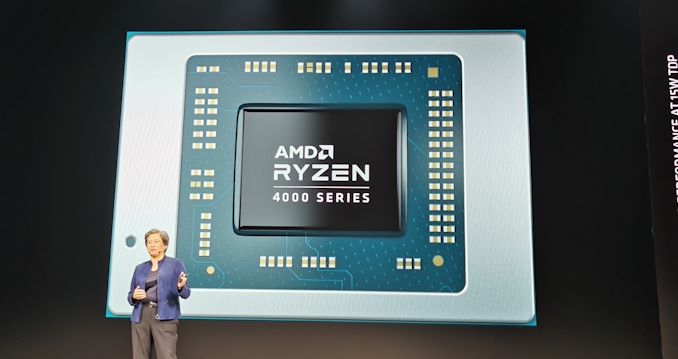
The notebook market has not been kind to AMD over the last decade – for a long, long time the company was only ever seen as the discount option for those on a strict budget. It didn’t help that OEMs only saw AMD in that light, fitting bulky units with sub-standard displays and storage options meant that even retailers were only presenting AMD as something for the budget conscious.
All that seems set to change. Fast forward to 2020, and notebook users are eagerly awaiting the arrival of products based on AMD’s latest Ryzen Mobile 4000 series processors, which combine up to eight Zen 2 cores and upgraded Vega graphics into a small CPU for the notebook market. AMD has already made waves with its Zen 2 cores in the desktop and enterprise space, and the company has already announced it plans to put eight of those cores, along with a significantly upgraded graphics design, into a processor that has a thermal design point of 15 W. These 15 W parts are designed for ultraportable notebooks, and AMD has a number of design wins lined up to show just how good an AMD system can be.
The same silicon will also go into 45 W-class style notebooks, with a higher base frequency. These parts are geared more towards discrete graphics options, for gaming notebooks or more powerful business designs. The gaming market (at 45 W), the commercial market (15W to 45W) and the ultraportable market (15 W) are where AMD is hoping to strike hardest with the new hardware.
Since earlier this year in January, at the annual CES trade show, we saw a number of early designs based on the new Ryzen Mobile 4000 family. These included TUF laptops from ASUS, the Lenovo Yoga Slim 7, Lenovo Thinkpads using Ryzen Mobile 4000 Pro, Dell’s G5 15 SE, the Acer Swift 3, and the ASUS Zephyrus G14 to name but a few. All of these are key design wins for different segments of the market, and the two that AMD seem to be pushing most are the Zephyrus and the Yoga Slim 7.

The rear panel of the ASUS Zephyrus G14 with its LED rear
The ASUS Zephyrus G14 is set to be the only 14-inch laptop on the market that has both a H-series processor, a 1080p 120Hz panel, and an RTX 2060 discrete graphics card solution in that form factor. The aim here is to have something both portable and high performance, with within the right thermal envelope, for gamers and users who need something with a bit more oomph while on the road, such as video editors who need up to 32 GB of DDR4 inside. There’s an added rear panel effect with moveable LEDs, just for a DJ to show off or to show a logo. The Zephyrus G14 will also be the first design with a HS-series processor, which we’ll cover in a bit.
The second key system AMD is promoting is an ultraportable, the Lenovo Yoga Slim 7. It comes with the highest grade Ryzen Mobile 4000 15 W U-series processor, the Ryzen 7 4800U, and is designed to turbo up to 25 W when needed based on the design of the chassis. Paired with Wi-Fi 6, a FreeSync display, and LPDDR4X, this is the system that AMD is using for all their battery life performance demonstrations.
AMD is working with Lenovo to source these units for press sampling, which should have been for today, however due to the world situation the shipment of these have been delayed, and users will start to see reviews from next month, even though they might be available in China before then.
The Processor Offerings
As with Intel’s mobile processors, AMD’s latest lines fall into two categories. For the ultraportable and low end gaming market, we have 15 W parts called ‘U-Series’. For the gaming market where discrete GPUs are used, there are 45 W parts called ‘H-Series’. The commercial market will take from both sets, and later in the year we might see mini-PC manufacturers (like Zotac, perhaps) use one or the other to bolster their portfolio.
Not previously announced until today is the AMD Ryzen 9 4900H family, the new halo Ryzen Mobile 4000 hardware. These are AMD’s first processors with the Ryzen 9 designation, and we have a specific news story about them here.
| AMD Ryzen Mobile 4000 APUs | |||||||
| AnandTech | Cores Threads |
Base Freq |
Turbo Freq |
L2 | L3 | GPU CUs GPU Freq |
TDP |
| H-Series | |||||||
| Ryzen 9 4900H | 8 / 16 | 3.3 GHz | 4.4 GHz | 4 MB | 8 MB | 8 / 1750 MHz | 45 W |
| Ryzen 9 4900HS | 8 / 16 | 3.0 GHz | 4.3 GHz | 4 MB | 8 MB | 8 / 1750 MHz | 35 W |
| Ryzen 7 4800H | 8 / 16 | 2.9 GHz | 4.2 GHz | 4 MB | 8 MB | 7 / 1600 MHz | 45 W |
| Ryzen 7 4800HS | 8 / 16 | 2.9 GHz | 4.2 GHz | 4 MB | 8 MB | 7 / 1600 MHz | 35 W |
| Ryzen 5 4600H | 6 / 12 | 3.0 GHz | 4.0 GHz | 3 MB | 8 MB | 6 / 1500 MHz | 45 W |
| Ryzen 5 4600HS | 6 / 12 | 3.0 GHz | 4.0 GHz | 3 MB | 8 MB | 6 / 1500 MHz | 35 W |
The H series processors are split into H and HS parts. For all except the Ryzen 9, the specifications between the two match, aside from the TDP, which is 45 W for the H and 35 W for the HS, but both of them are considered ‘H-Series class’ processors. Technically the H series can be de-rated to run at 35 W, however to get the S in the name requires collaboration with AMD, which we’ll get into later.
| AMD Ryzen Mobile 4000 APUs | |||||||
| AnandTech | Cores Threads |
Base Freq |
Turbo Freq |
L2 | L3 | GPU CUs GPU Freq |
TDP |
| U-Series | |||||||
| Ryzen 7 4800U | 8 / 16 | 1.8 GHz | 4.2 GHz | 4 MB | 8 MB | 8 / 1750 MHz | 15 W |
| Ryzen 7 4700U | 8 / 8 | 2.0 GHz | 4.1 GHz | 4 MB | 8 MB | 7 / 1600 MHz | 15 W |
| Ryzen 5 4600U | 6 / 12 | 2.1 GHz | 4.0 GHz | 3 MB | 8 MB | 6 / 1500 MHz | 15 W |
| Ryzen 5 4500U | 6 / 6 | 2.3 GHz | 4.0 GHz | 3 MB | 8 MB | 6 / 1500 MHz | 15 W |
| Ryzen 3 4300U | 4 / 4 | 2.7 GHz | 3.7 GHz | 2 MB | 4 MB | 5 / 1400 MHz | 15 W |
The U-series parts, by the nature of the lower TDP, ultimately have a lower base frequency than the others. These CPUs also tend to rely more on the integrated graphics, which means that the power budget is often split between the CPU and GPU. AMD is also going for an interesting mix here of parts with-and-without simultaneous multithreading. The bottom processor, the Ryzen 3 4300U, even has half of its L3 cache disabled.
All of these CPUs support DDR4-3200 (up to 64 GB, 51.2 GB/s) and LPDDR4X-4266 (up to 32 GB, 68.3 GB/s), and it will be up to the OEM which one to use: LPDDR4X should offer better idle battery life and peak performance, but DDR4 offers more capacity. It is likely that we’ll see the ultraportable market use LPDDR4X, while the more gaming and workstation class systems will use DDR4.
All of the CPUs are PCIe 3.0 only, rather than PCIe 4.0 like the desktop parts. This is primarily due to power – the double bandwidth of PCIe 4.0 requires more power, and given that storage or graphics rarely need peak speeds, AMD felt the product portfolio would prefer battery life in this regard. Each chip has sixteen PCIe 3.0 lanes, split such that x8 is available for a graphics card, and two x4 links for storage. There are separate PCIe lanes for other modules such as Wi-Fi 6 or mobile network access (4G/5G).
Display support for the CPUs allows for two 4K monitors through DisplayPort over Type-C, an additional 4K monitor if Thunderbolt is used, and a fourth monitor if USB 4.0 used. AMD has designed Renoir to not need additional chips to detect which way a Type-C is connected – that is all handled on die. With the display and USB support, the processor allows for concurrent USB 3.2 and DisplayPort use, with the peak DP v1.4 8.1G HBR3 standard in play using display stream compression (DSC).
Silicon Details
AMD surprised us by offering some details on the silicon here. The APU was manufactured on TSMC’s N7 process (7nm DUV), using a 13-layer metal stack. The whole die is 9.8 billion transistors. In January, we calculated through photography the die size to be about 150-151 mm2. AMD is stating that it is 156 mm2, which given previous measurements, probably doesn’t include scribe lines.
While we don’t have performance numbers for Renoir today, due to world events, we do have some deeper details into the platform that have not been disclosed before. These cover CPU and GPU improvements, significant changes to power management, Infinity Fabric, and how AMD is taking better control of thermals, performance, and battery life this type around.
AMD has stated that they expect to see 100+ designs using Renoir this year, with a number of those being key design wins that the company has not had in recent memory. Considering where the company was only four years ago, surrounded in a vicious negative feedback loop, this is a significant upswing in OEM participation, putting AMD in premium designs. Ultimately it’s the consumer who wins, as we should now see some serious competition in the notebook market.


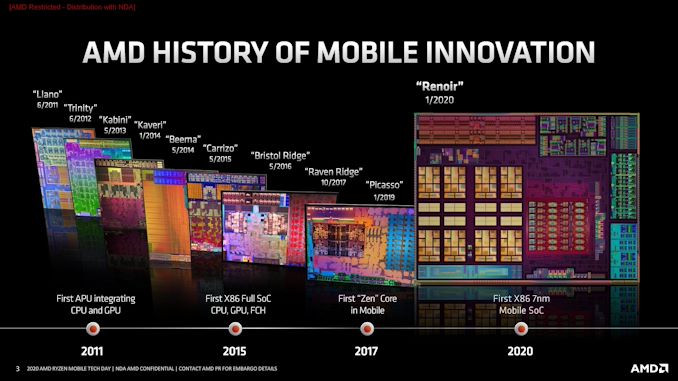
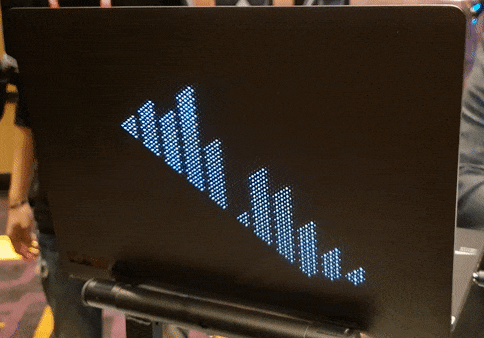
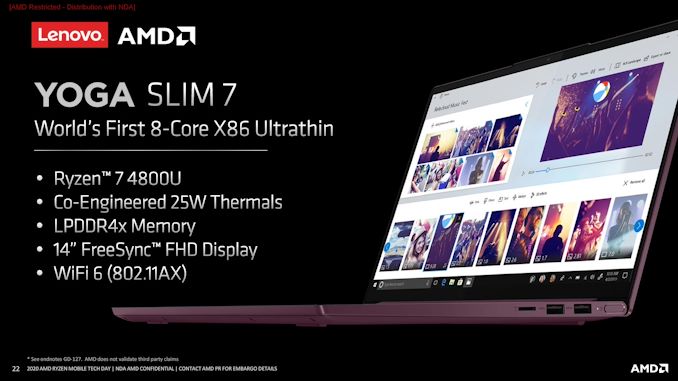
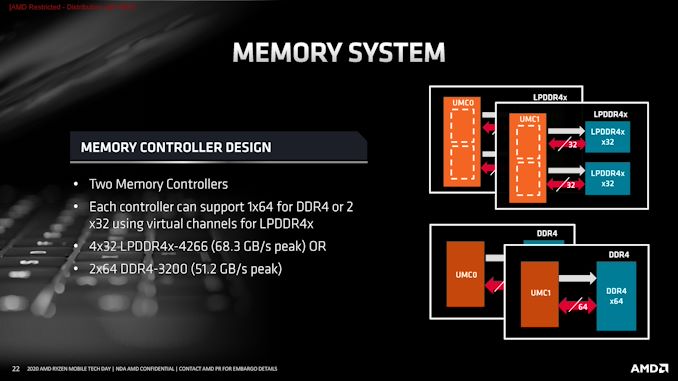

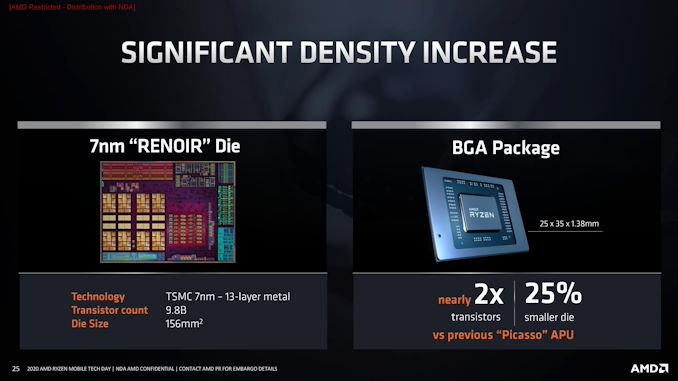








95 Comments
View All Comments
uibo - Monday, March 16, 2020 - link
HTPC market insignificantSamus - Tuesday, March 17, 2020 - link
I mean realistically there isn't anything a 10w Atom can't decode anymore...everything is overkill for HTPC.As far as encoding, for what the general consumer does (twitch, etc) any midrange CPU can handle that in the background on top of any other tasks you demand. It won't be a 10-15w part, but certainly a 35w part.
R3MF - Tuesday, March 17, 2020 - link
even AV1?bearing in mind that a new htpc has a ~6 year life and AV1 is the future of streaming video.
close - Tuesday, March 17, 2020 - link
I have an X5-Z8350 Atom tablet at home, I will give it a run with an AV1 encoded full HD Youtube stream and see if it handles it reasonably. I would assume that a box with more adequate cooling would do even better.PeachNCream - Tuesday, March 17, 2020 - link
Have to agree with this. HTPCs had a very brief glimmer of market presence a few years ago, but they never really took off or make a substantial enough splash. The population at large has little interest in adding the relative complexity of a computer to their media viewing experience and most home users are purchasing laptops, not even desktops, which are even less well-suited to acting as a fixed system attached to a large display panel. If AMD does grab that market, it will not be a measurable number of sales to say the least.Spunjji - Tuesday, March 17, 2020 - link
I love my HTPC and am excited to rebuild it around Renoir, and I fully endorse the sentiment of this post. Most people get by with a Fire stick or the built-in "smart" features of your average modern TV.PeachNCream - Tuesday, March 17, 2020 - link
If I had time and was more interested in consuming video content, I would probably dive into building a HTPC as well, but it would be to appeal mainly to a desire to tinker. From a practical standpoint, I would be hard-pressed to find a credible amount of work for computer dedicated to that task because watching videos isn't something I do when I'm not on an exercise bike and my phone is good enough for that chore.stephenbrooks - Tuesday, March 17, 2020 - link
Laptops make pretty good "HTPCs"... I plugged mine into a projector and sound system just today in factDanNeely - Monday, March 16, 2020 - link
For power efficiency media en/decoding is normally done with fixed function hardware; doing it in software on the GPU's general purpose cores eats power like crazy. AV1 not being present means Renoir doesn't have a fixed function block - whether due to not being done yet, taking too much die area, or something else - but not being here means you're going to have to wait until the 5000 series APUs to get support in an AMD CPU.Santoval - Tuesday, March 17, 2020 - link
Bear in mind that this year will see the release of no less than *three* new video codecs. MPEG plan to release H.266/VVC (Versatile Video Coding), EVC (i.e Essential Video Coding) or MPEG-5 Part-1 and LCEVC (i.e. Low Complexity Enhancement Video Coding) or MPEG-5 Part-2. Each codec is targeted at a different market. For instance H.266/VVC is the direct successor of H.265/HEVC, while EVC is partly targeted against AV1 (its baseline profile, which is ~30% more bitrate efficient than H.264, will be royalty free).LCEVC is not so much a new codec but a new technique to combine two layers of any two codecs at any resolution in a "hybrid" (stacked) way, in order to reduce computational complexity. Which works apparently. I place a link at the end of the comment which explains how that works. In other words the codec market of the next couple of years is going to quite more loaded and competitive than simply choosing between H.265, VP9 and AV1. This is something chip manufacturers will almost certainly take into account.
By the way, it is not yet fully clear if AV1 is going to be royalty free. Sisvel launched a patent pool for AV1 last year. Whether it has merit or not remains to be seen. However, patent confusion is worse than paying royalties for patents. If chip manufacturers have plans to add decoding and encoding support for VVC and EVC, for instance, they have already accounted the costs. But if they add AV1 support thinking it was patent free and then Sisvel goes to court to sue that would be a very unpleasant and unexpected surprise. Sisvel's patent claims are going to stall AV1 support unless they are resolved.
https://www.streamingmedia.com/Articles/ReadArticl...